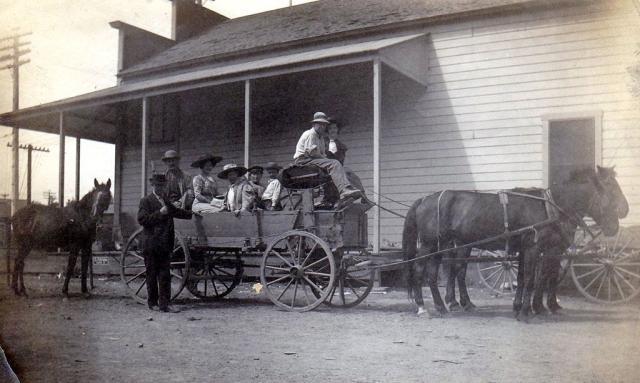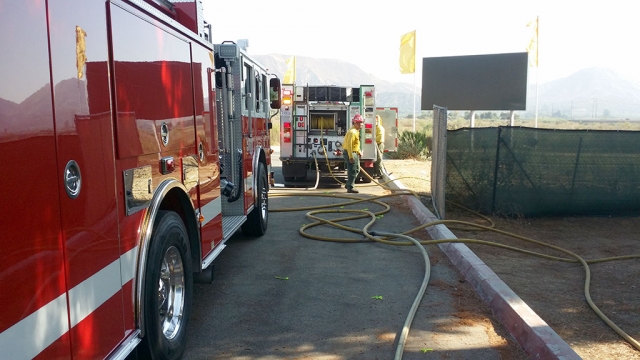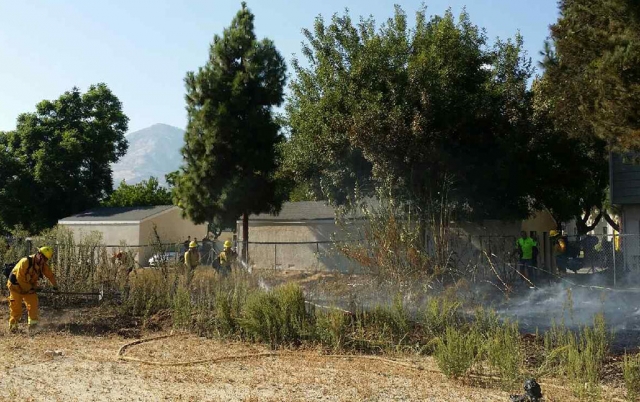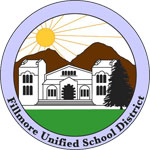|
By David W. Rowlands — Wednesday, September 16th, 2020
The City Council of Fillmore wants your input. The City, working with the Conflict Resolution Institute, will be hosting a virtual Community Conversation, on Saturday, September 26 from 10:00 am to 11:30 am. Small break out groups will be used and we will have English and Spanish language groups and interpreters. You may participate via phone or computer. The community conversation is designed to see how the community feels, highlight specific experiences, and understand what the next steps envision. The City Council is committed to making life better for everyone in the community. The only way that the City Council can know your experiences and thoughts is through your participation. To register for this event the link is, https://www.eventbrite.com/e/the-city-of-fillmore-virtual-community-conv... Registration is also available on the following city social media platforms – city web page, Facebook, Instagram and Twitter. Let’s work together to keep Fillmore the “Best Last Small Town.” |
|
By Anonymous — Wednesday, September 16th, 2020
 Fillmore High School’s soon to be Career Tech Education building. Crews worked all week installing steel framing for the tech building. The construction has been making good progress despite the COVID-19 pandemic. Enlarge Photo |
 A wagon and horses at the side of Piru Co. Op. (c) 1910. Photos Courtesy Fillmore Historical Museum. Enlarge Photo By Anonymous — Wednesday, September 16th, 2020
 Piru in 1906. The Ventura County Cooperative which would become United Mercantile, Piru Billiards, and the Piru Post Office. Enlarge Photo Courtesy Fillmore Historical Museum In 1930 and 31, the Piru News ran a series of articles entitled, “What Piru Has….” The paper described the series as “a series of weekly articles describing the various industries, products, organizations, schools, business houses of Piru and vicinity.” Two of the issues addressed the business that were in Piru. Below is the first of the two articles. PIRU BUSINESS Part 1 The Bank of America, a branch institution until last week under the name Bank of Italy, has been operating as a part of the great banking chain since February 8 when it was taken over from the Fillmore State Bank. The state bank started here in June 1918 as a branch of the Fillmore institution. In good times deposits at the local bank have reached a total of $350,000. Owing to business depression deposits just now are under that figure. The bank was started as a one-man affair by W. L. Ramsay who operated it for six months. Clyde E. Spencer then took charge and managed it for three years when he resigned to enter the real estate business. James Brady is the present manager and is assisted by Leo Sheffield. teller. Brady declares that all charges for various transactions are unusually low at the local bank. The bank owns its own building, a neat brick structure at Center and Main streets. The Drugstore: An up-to-date drugstore carrying a complete line of articles usually sold in a modern pharmacy is operated by E. C. Brehm, who has been in the drug business for 31 years and who has been a registered pharmacist 24 years. A large line of soft drinks and ice cream concoctions are sold at the soda fountain. All kinds of drugs, drug sundries, patent medicines, toilet articles, stationery, clocks, magazines, etc., are sold here. Brehm makes a specialty of filling prescriptions. The owner came here three years ago and about a year ago built the red brick structure that houses the store. The business was purchased from A. L, Wilkie, who gave Piru its first drugstore on November 25, 1925. Brehm has been a druggist in Missouri, Kansas and Texas. Situated beside the bank is the Ideal Billiard Parlor and Barbershop of T. H. Green who built the brick structure in which the business is housed four years ago after operating in another structure for three years. Two barber chairs and a soft drink, tobacco and cigar counter are located in the front room. In the rear there are two pool tables and two snooker tables which usually are kept busy especially of evenings. Macy’s Grocery Store, operated by Mrs. Laura Macy and her son, Les, stands beside Green’s barbershop and is housed in a brick building erected by the Macys about the same time the barbershop structure was built and is the same size. The business is one of the Blue & White stores, which means that it is owned locally by an Independent dealer but that goods are purchased from the Blue & White concern. A high-grade line of groceries, canned goods, fruits, some vegetables. cigars, tobaccos and candies are handled here. The Macys took over the store seven years ago from T. T. Kirkham who operated across the street, where Mrs. Delis Trotter now has a furniture store. The grocery enjoys a large trade from both the town and country people. Cornelius Store: W. G. Cornelius operates the next store down the street in conjunction with the post office. Everything from post cards to radios and from clocks to overalls are sold in this store but especially gents furnishings, notions, confectionery, cigars, magazines and tobacco. Cornelius built the store building this year. It is a neat stucco structure with cement floor and is one of the coolest places in town on hot summer days. The proprietor has been in business here ten years. At one time in partnership with Hugh Warring, he started a store in the Buckhorn district, had one in Piru and later bought a third here and started what was known as the Ventura Cooperative association. Cornelius managed the three stores until his health failed. For a time after coming to Piru. he had a health resort in Lechler canyon, but this was destroyed by fire and a flood, The Piru Furniture Store, operated by Mrs. Delia Trotter, had a unique beginning. Mrs. Trotter says that she and her husband had so many household articles that they did not know where to keep them. These things were stored in their garage and everywhere possible. One day she had a bright idea. She suggested that if her husband would put a floor in the garage, she would open a secondhand furniture store and sell the belongings. This proposal was carried out at once and “things went like hot cakes," Mrs. Trotter said, because there were so many oil workers in town then. The neighbors took advantage of the opportunity and bought furniture and other articles they didn’t want, and Mrs. Trotter sold them. After that Mrs. Trotter went into the business in earnest. She moved into her brick building on Center street and has increased her stock to include both new and used furniture, kitchen utensils, dishes, rugs, etc. Her store is now in its fourth year. To be continued... |
 Marie Wren has served as a volunteer for the National Historic Landmark for over twenty years and has donated over 200 books to the Rancho Camulos Research Library. In honor of her work and generosity, the library was renamed the “Marie Wren Research Library.” The library holds a collection of books on Southern California history, photos, maps and more. Photos courtesy Rancho Camulos Museum. Enlarge Photo By Anonymous — Wednesday, September 9th, 2020
Piru, CA – It’s a small, cozy room—only about 200 square feet—but without question is one of Ventura County’s most valuable hidden gems. The Rancho Camulos Museum Research Library, located in the museum’s 1920 adobe restored house facing Highway 126, is home to a variety of historic treasures, including rare books, an extensive collection of books on Southern California history, historical photos, maps and documents dating from the nineteenth century. The library and its archival collection is complemented by a treasure trove of early nineteenth and eighteenth-century artifacts original to the property. Museum volunteers and staff recently completed cataloguing the museum’s collection of books and several of its most significant archival collections. To honor this milestone, the museum’s board of directors earlier this month named the research library in honor of Fillmore resident Marie Wren, who served as a charter volunteer for the National Historic Landmark’s and the non-profit’s first docent council chair more than twenty years ago. More recently Wren donated more than 200 books from her personal collection on Southern California, California and American West history and fiction to the library. Wren also made a handsome donation to Rancho Camulos that enabled the museum to purchase shelving, furnishings, and archival supplies, creating a comfortable working space for researchers and the museum’s archival staff. “Without Marie’s dedication to Rancho Camulos Museum, her support of our research library and generous donation, we would not have been able to make this happen, notes Dr. Susan Falck, the museum’s executive director. “She is truly an inspiration to everyone who works on behalf of this museum. Her passion for California history and Rancho Camulos history is contagious.” Prior to the creation of the museum library and research center, much of the museum’s artifacts and archival materials lay scattered among several rooms and buildings on the twelve-acre museum grounds. In early 2014, volunteers began gathering these materials for safekeeping. Once the 1920 adobe was restored it became possible to begin cataloging and conserving numerous documents and artifacts. Dianne Cox, who has served as a museum volunteer for 13 years, led this sizable undertaking and has put countless hours into creating a comfortable, well-organized workspace, meticulously cleaning and conserving fragile items and later helping to catalogue the materials along with Falck and museum board member Meredith McGowan, who works as a professional librarian for Los Angeles County. "Working with Marie in the library, sorting and cataloging her books, and listening to her stories, was a wonderful experience for me,” notes Cox. “It was obvious she loved her books and she loved history". Wren, a native of Oklahoma who moved to Fillmore in 1947, joined the museum as a volunteer shortly after the 1994 Northridge Earthquake severely damaged several buildings at Rancho Camulos. She has served as one of the museum’s strongest advocates over the years, helping raise funds to restore the museum’s 19th-century buggy and other projects, recruiting new volunteers, developing the museum’s tour program and uncovering the history of Camulos Ranch by steadily acquiring books about rancho and Southern California history. Recently, a collection of vignettes Wren wrote about local families and events that appeared in local newspapers was published as Stories to Be Told: Tales about the pioneer people and places in little Santa Clara River valley, Southern California. Over the past several years Rancho Camulos has opened its collection to scholars from Yale University, UC Berkeley, Loyola Marymount and Cal State graduate students eager to learn more about the rancho era in Southern California and the families and laborers who established and operated one of the oldest and most successful agricultural operations in Ventura County. The museum also periodically loans out items from its collection to other institutions. Currently, the Smithsonian’s Museum of American History is showcasing several religious artifacts from Rancho Camulos in an exhibit entitled “Many Voices, One Nation.” Once the pandemic has subsided, the museum looks forward to once again making its research collection accessible to the public, according to Falck. “In the meantime, we continue organizing our collection and uncovering new treasures.” To learn more about the Rancho Camulos Museum research library, email info@ranchocamulos.org or visit the museum’s website at www.ranchocamulos.org. |
|
By Anonymous — Wednesday, September 9th, 2020
 Saturday, September 5th at 4:17pm a fire broke out behind the River Ridge Apartment complex on River Street. Fillmore Fire Department had the blaze under control in approximately a half an hour, with only minor damages caused to the surrounding area. No houses were damaged and cause of the fire is still under investigation. Inset are crews clearing some of the burned vegetation and searching for any hot spots that might reignite. Enlarge Photo |
|
By Anonymous — Wednesday, September 9th, 2020
 Fillmore High’s new CTE (Career Tech Education) building took another great step forward on Friday, September 4th with the start of a large concrete pour with multiple trucks. Fillmore Unified School District’s Superintendent Dr. Adrian Palazuelos said, “I am pleased to report that work is progressing based on positive reports from our construction manager. Everyday is another step towards realizing our new Ag and Transportation facilities.” Enlarge Photo |
|
By Anonymous — Wednesday, September 9th, 2020
 It’s sad to report the closure of Elkins Ranch Golf Course here in Fillmore. A press release from Carla Corral, President of Elkins Ranch Company, founded in 1930, states: “After two decades of declining play and ever increasing expenses, and the impact of the COVID-19 pandemic, the Board of Directors has determined that the company can no longer remain viable with the golf course as the core of its business model.” Goodbye to the birds and squirrels of that peaceful place. Enlarge Photo |
|
By Anonymous — Wednesday, September 9th, 2020
 Driving along Highway 126 next to the El Dorado Mobile Home Park in Fillmore is the Heritage Grove housing development. This past Tuesday, September 8th workers were seen roofing and framing off multiple houses making some steady progress, despite the COVID-19 pandemic. Enlarge Photo |
|
By Anonymous — Wednesday, September 9th, 2020
September 1, 2020 INFORMATION/DISCUSSION ITEMS: APPROVE GOVERNANCE HANDBOOK APPROVE CERTIFICATION OF SIGNATURES FOR FISCAL YEAR 2020-2021 APPROVE CHANGE ORDER #5 FOR FHS EXISTING CTE BUILDING DEMOLITION & CTE NEW BUILDING CONSTRUCTION PROJECT APPROVE PERSONNEL ORDER 20-21-3 TEMPORARY PROCEDURES FOR VIRTUAL PUBLIC PARTICIPATION IN SCHOOL BOARD MEETINGS Next Meeting Regular Meeting, Tuesday, September 15, 2020, Open Session - 5:30 pm Closed Session - 5:30 pm at 627 Sespe Avenue, Fillmore CA 93015 |
 The First Bardsdale School. The contract for construction of the school was given to Mr. O.J. Goodenough who was to build and furnish the school for $1,397. Photos Courtesy Fillmore Historical Museum. Enlarge Photo By Anonymous — Wednesday, September 9th, 2020
Courtesy Fillmore Historical Museum As we begin the new school year I thought it might be interesting to look back at schools at the beginning of development in the area now known as Bardsdale. The history of the Bardsdale School is really the history of Bardsdale. In 1888, Mr. Thomas Bard of Hueneme bought land from the More brothers. His partner, Royce Surdam, laid this property out in farming tracts around a Community Center. To this settlement he gave the name of Bardsdale. There were no citrus orchards then. People raised what they thought would grow the best. Though the crops were good, the market was poor. Mrs. Chadsey told of a very fine cabbage crop from which they only sold one head. The next year, they raised potatoes and though they had a pile higher than the house they sold none of them. It was hard for the people to make a living and some who came moved on to other places. There was a large German colony which had come from the Middle West. They held the first school classes in their little church which was on the east side of Owen Street. The first school board meeting was held May, 1888. Two members, J.C. Wilson and B. Broderson, were appointed by the County Superintendent. Brice Grimes was a member by virtue of the statute law (he lived in the school district). Their first duty was to call an election. The election was held in Bardsdale in Robertson’s store. There were eight votes cast. Henry Klages and B.T. Chadsey were elected to the board. On May 22, 1888, the newly elected board employed Miss Nettie Hamilton to teach three weeks the following August. Miss Jessie Fuller was employed to teach four months at $65 a month. The community was still without a school building. Mr. Bard had given land on Ventura St. for a school building but there were no funds for construction. On October 20, 1888, eleven votes were cast for the purpose of raising $1,722.00 in order to build a school house and furnish it. The school year was divided into two parts. Miss Fuller’s term closed December 14th and on February 11, 1899, Miss Gibbins began the second term at $60 a month. (There is no word about what happened to Miss Hamilton) Mr. O.J. Goodenough was awarded the contract to build the Bardsdale Schoolhouse according to the plans and specifications. He was to furnish all material and finish the job in a good and workman like manner for $ 1,397.00, excepting outhouses. On June 8, 1889, the new school was accepted by the trustees. It was then moved and carried, unanimously, “that the school house should not be used for dancing and that smoking and chewing tobacco be prohibited in the schoolroom and smoking on the ground. In August, 1889, Miss Minnie Taylor had the honor of being the first teacher in the new school house. The school consisted of one room and a cloak room. There were two entrances, one for the boys and one for the girls. A huge iron stove stood in the back of the room. On rainy days, the children would take off their shoes and stockings and dry them around the fire. The desks and seats were made for two people and if a pupil was good, he or she was allowed to choose their desk partner. The teacher did her own janitor work with the help of the older children. There was no water on the school grounds and it was considered an honor to be allowed to go fetch it. The water bucket was set in the cloak room where all the children drank from the same dipper. Fridays were red-letter days. The children held spelling bees and gave recitations. The adults who belonged to a literary society came to the school in the evening to study and debate. One of the topics of debate was “Can the Santa Clara River be Bridged?” Box socials were held from time to time. In the beginning there were thirty or forty children. There were nine grades in the school because the nearest high school was in Santa Paula and often the river crossing to Santa Paula was impassible. By 1895, there were over 60 children in the school and so another room was added to the school. When school began in 1896 there were two teachers each paid $50 a month and a janitor who received $6 a month. One year later, in 1896 a principal had been hired at $65 a month. The school continued to grow each year until in 1917, when the need for a larger school became critical. The new school that was built included 4 rooms, a library and teachers’ room. The cost was $18,000.00. The grounds were improved by the addition of a front walk, lawn, shrubs and playground equipment as well as tennis courts and school garden. Throughout the decades, children arrived at the school either walking or on horseback. One child boasted of a buggy. When the Riverside School district located at the foot of Balcom Canyon closed, those children needed a ride to school. A Model A Ford was modified by “experienced” hands to serve the purpose. It lasted until spring 1932 when it gave out all at once one fine morning. Bardsdale School had one of the earliest PTA organizations although it wasn’t called by that name. It was originally called the “Congress of Mothers”. It was organized in 1925 or 1926 and started with meetings of the parents during the day. But soon the group noticed that many of the small children who walked to school each day arrived without breakfasts and sometimes with very little lunch. They decided to do something about it. The mothers began to take turns bringing the children hot lunches which they prepared at home. After lunch two of the mothers would stay and wash the dishes. Soon they raised enough money with cake sales to purchase cooking utensils and hot plates. They cooked lunch in the hallway and served the children on tables built for that purpose. The end for Bardsdale School came in 1966 when the building failed Field Act earthquake specifications. The school was closed and the children joined their junior high and high school siblings traveling to school in Fillmore. The old school bell that had hung in the tower of the old school was eventually given to the Fillmore Historical Museum where it has been rung by each child who visited the museum with their classes. |













